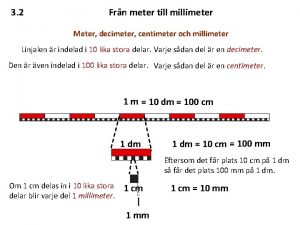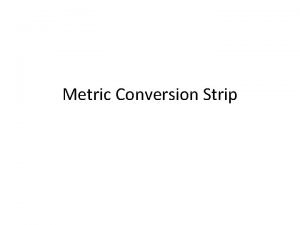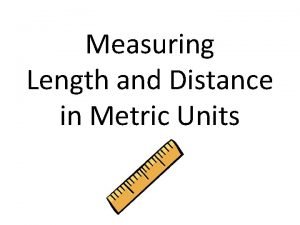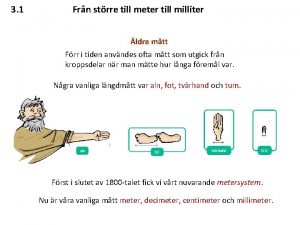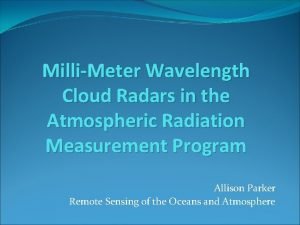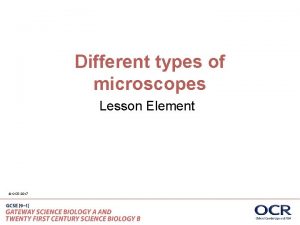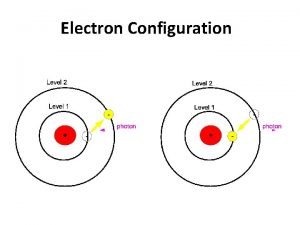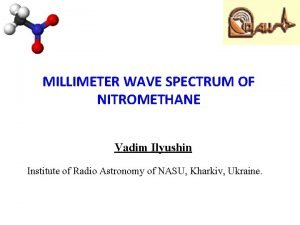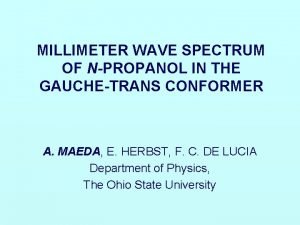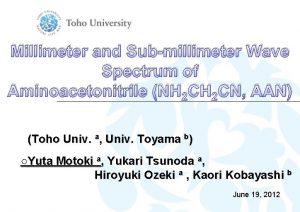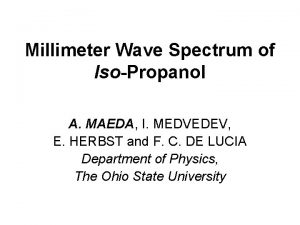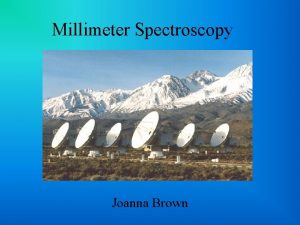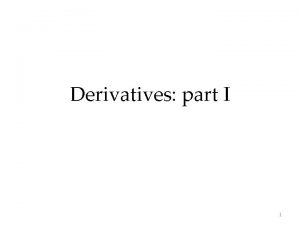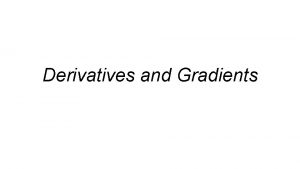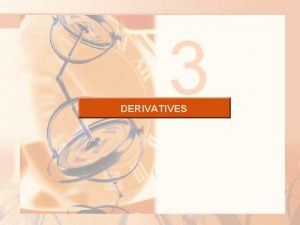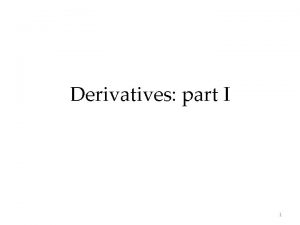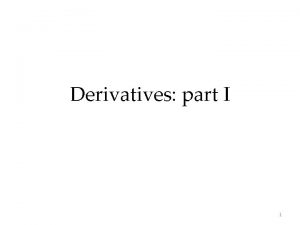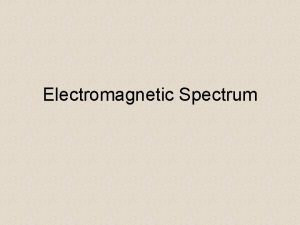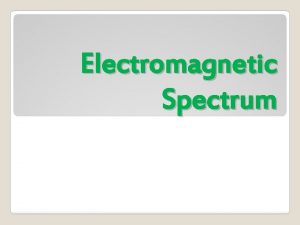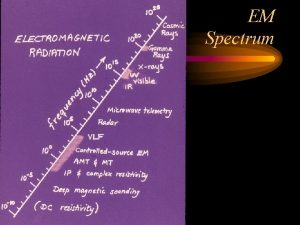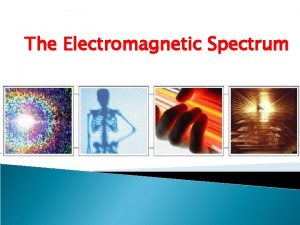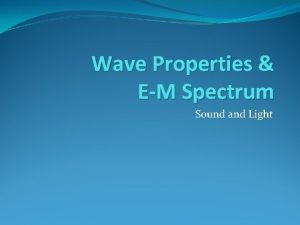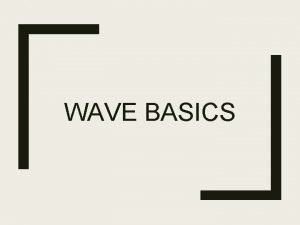Millimeter wave spectrum of the two monosulfur derivatives




















- Slides: 20

Millimeter wave spectrum of the two monosulfur derivatives of methyl formate: S- and O-Methyl thioformate, in the ground and the first excited torsional states Wednesday, June 21, 2017 Presented by: Atef JABRI International Symposium on Molecular Spectroscopy Mini-symposium: ALMA’s Molecular View

Introduction Ø Rotational spectroscopy is a powerful tool for detecting molecules in space Ø In fact, microwave and millimeter wave spectra of Molecules are necessary to the search in the interstellar medium by comparing them with observed data from radiotelescopes ØHowever, molecules containing large amplitude motions (internal rotation for example) are not obvious to detect since their spectra are more difficult to analyse.

Introduction: Strategy Observations ALMA: 84 -720 GHz Millimeter wave spectroscopy Search in the MIS The Lille solid-state based spectrometer Orion Modeling Zbigniew Kisiel BELGI for internal rotation analysis

Introduction: An efficient Strategy… Detection for the first time of methyl acetate in the interstellar cloud Orion B. Tercero, I. Kleiner, J. Cernicharo et al. , Astrophys. J. L. , 770(1), L 13, 2013 Detection of methyl formate isotopologues (13 C and D) L. Margules et al. , Astrophys. J. , 714, 1120, 2010

Internal rotation specifity: * W. Gordy and R. L. Cook « Microwave molecular spectra » * Lin and swalen « Internal rotation and microwave spectrscopy » Potential energy Internal rotation effect: splittings of energy levels splittings of lines in the spectrum V 3 Torsional angle AA AAE EA EE E EE* Frequency

Methyl thioformate (MSCHO/MOCHS) : Motivation J. Cernicharo et al. , Astron. Astrophys. , 181, L 9, (1987) Methyl formate: a relatively abundunt molecule in the interstellar medium E. Chruchwell and G. Winnewisser, Astron. Astrophys. , 45, 229 -231 (1975). S-Methyl thioformate MSCHO O-methyl thioformate MOCHS

Previous investigations on methyl thioformate Theoretical calculations: M. L. Senent et al. , J. Chem. Phys. , 141(10), 104303, (2014) Experiment: G. I. L. Jones, D. G. Lister, N. L. Owen, J. Mol. Spectrosc. , 60, 348 (1976) W. Caminati, B. P. V. Eijck, D. G. Lister, J. Mol. Spectrosc. , 90, 15 (1981) Only 58 rotational A/E Lines were measured up to 40 GHz. E line species dues to internal rotation are not well reproduced

Preliminary work: Chemical Synthesis Collaboration with J. -C. Guillemin from the « Ecole Nationale de Chimie de Rennes » Methyl-mercaptan Formic-acetic anhydrid Spectrum measurement between 150 -660 GHz at T=300 K Thanks to the Lille solid state based spectrometer. Intensity/ u. a Frequency / GHz

1) S-Methyl thioformate: Analysis of the spectrum Comparaison of measured spectrum with calculations from BELGI-Cs program obtained from previous experimental data BELGI-Cs calculations is shifted by up to 10 MHz for a-type lines of the Rbranch (Ka=0)

1) S-Methyl thioformate: Analysis of the spectrum Assigment was performed with and iterative process Assignment BELGI-Cs Fit Analysis Improvement of parameters New calculation

1) S-Methyl thioformate: Analysis of the spectrum Comparaison of measured spectrum with calculations from BELGI-Cs program obtained from our best fit

1) S-Methyl thioformate: Analysis of the spectrum Our best fit in the ground torsional state with BELGI-Cs includes 2254 lines from our new measurements and 58 lines from littérature. 34 spectroscopic parameters were determined in this fit (A, B, C, DJK, V 3, ρ. . . ) Ground torsional state vt = 0 BELGI-Cs Fit Jmax Kmax Line number Exp. Accuracy (k. Hz) r. m. s (k. Hz) 70 15 2137/117/53 30/100/150 27. 8/84. 6/90. 6 Rotational lines measured in the millimeter wave spectral region between 150 -660 GHz are reproduced to experimental accuracy.

1) S-Methyl thioformate: Internal rotation effect Analysis of the internal rotation is not obvious as the barrier hight to internal rotation is rather low (V 3 ≈ 135 cm-1) which leads to strong splittings.

1) MSCHO: Analysis of the first excited state vt = 1 Correlation between spectroscopic parameters is high. Then we need to analyse the excited torsional state to better determine the interaction between overal and internal rotation BELGI-Cs Experiment

1) MSCHO: Analysis of the first excited state vt = 1 BELGI-Cs Fit Only vt = 0 Global fit vt = 0 & vt = 1 Caminati et al. (1981) APAM (MHz) 10995. 485(56) 11008. 0614(06) 11035. 13(0. 19) BPAM(MHz) 5113. 435(64) 5124. 5842(50) 5099. 99(0. 13) CPAM(MHz) 3574. 9724(32) 3569. 51926(17) 3561. 57(0. 03) өRAM 74. 616649(18) 74. 5594730(20) 73. 71(0. 18) V 3 (cm-1) 147. 419(13) 134. 302(20) 150. 47(1. 67) F (cm-1) 5. 531 (fixed) 6. 4230(40) 5. 531 (fixed) Jmax 70 70 20 Kmax 15 25 6 Line number 2307 3184 58 Std. Dev. (unitless) 0. 92 1. 47 1. 29/1. 80 Work on first and second excited torsional states is in progress but available spectroscopic parameters should be sufficient to produce a reliable linelist for an astronomical search

2) O-Methyl thioformate (MOCHS) J. Cernicharo et al. , Astron. Astrophys. , 181, L 9, (1987) Methyl formate: a relatively abundunt molecule in the interstellar medium E. Chruchwell and G. Winnewisser, Astron. Astrophys. , 45, 229 -231 (1975). S-Methyl thioformate MSCHO O-methyl thioformate MOCHS

2) O-Methyl thioformate (MOCHS) Chemical Synthesis Collaboration with J. -C. Guillemin from the « Ecole Nationale de Chimie de Rennes » Spectrum measurement between 150 -660 GHz at T=300 K Thanks to the Lille solid state based spectrometer.

2) MOCHS: Analysis of the ground torsional state M. L. Senent et al. , J. Chem. Phys. , 141(10), 104303, (2014) No experimental data yet for this species Assignments of the A species from ab initio constants Splittings of energy levels due to internal rotation should be smaller for this species and XIAM code is used for fast assignment Same strategy for the assignment MOCHS spectrum as for MSCHO Ground torsional state vt = 0 Preliminary results from XIAM Jmax Kmax Line number XIAM Fit 40 10 500 r. m. s (k. Hz) 43

Conclusion & Perspectives: Analysis of MSCHO spectrum measured between 150 and 660 GHz. Standard deviation is in the same order of magnitude with experimental accuracy. Excited states should be assigned in order to improve the quality of our analysis and to completely eliminate correlations between parameters. Analysis of MOCHO spectrum is also performed using the XIAM program as a first step. However, BELGI-Cs top should be used for the analysis of all the spectra in order to better determine higher order spectroscopic constants Linelists of both of these species will be available soon for search in Sgr(B 2).

Thank you for your attention Acknowledgements: Gd. R SPECMO 20
 Orbital diagram for cu
Orbital diagram for cu Absorption spectrum
Absorption spectrum Meter decimeter centimeter millimeter
Meter decimeter centimeter millimeter Millimeter in a sentence
Millimeter in a sentence Nearest milimeter
Nearest milimeter Distance in metric system
Distance in metric system Meter decimeter centimeter millimeter
Meter decimeter centimeter millimeter Millimeter cloud radar
Millimeter cloud radar Pathology definition
Pathology definition Mm, cm, m km conversion chart
Mm, cm, m km conversion chart Em spectrum song lyrics
Em spectrum song lyrics Light wave chart
Light wave chart Em waves spectrum
Em waves spectrum Sound waves are electromagnetic waves true or false
Sound waves are electromagnetic waves true or false What is a semiconductor used for
What is a semiconductor used for Difference between full wave and half wave rectifier
Difference between full wave and half wave rectifier Transverse and longitudinal waves both *
Transverse and longitudinal waves both * Half full wave rectifier
Half full wave rectifier Full wave bridge rectifier diagram
Full wave bridge rectifier diagram Earthquake p wave and swave travel time
Earthquake p wave and swave travel time Rectified sine wave fourier series
Rectified sine wave fourier series


